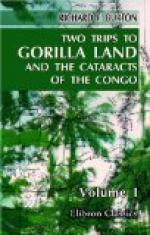The general aspect of the region is prepossessing. It is a rolling surface sinking towards the Atlantic, in parts broken by hills and dwarf chains, either detached or pushed out by the Ghats; a land of short and abnormally broad rivers, which cannot, like the Congo, break through the ridges flanking the Central African basin, and which therefore are mere surface drains of the main ranges. The soil is mostly sandy, but a thin coat of rich vegetable humus, quickened by heavy rains and fiery suns, produces a luxuriant vegetation; whilst the proportion of area actually cultivated is nothing compared with the expanse of bush. In the tall forests, which abound in wild fruits, there are beautiful tracts of clear grassy land, and the woods, clear of undergrowth, resemble an English grove more than a tropical jungle. Horses, which die of the tsetse (Glossina morsitans) in the interior of North Guinea, and of damp heat at Fernando Po, thrive on its downs and savannahs. The Elais palm is rare, sufficing only for home use. The southern parts, about Cape Lopez and beyond it, resemble the Oil River country in the Biafran Bight: the land is a mass of mangrove swamps, and the climate is unfit for white men.
The Eastern Ghats were early known to the “Iberians,” as shown by the Sierra del Crystal, del Sal, del Sal Nitro and other names, probably so called from the abundance of quartz in blocks and veins that seam the granite, as we shall see in the Congo country, and possibly because they contain rock crystal. Although in many places they may be descried subtending the shore in lumpy lines like detached vertebrae, and are supposed to represent the Aranga Mons of Ptolemy, they are not noticed by Barbot. Between the Camarones River and Cape St. John (Corisco Bay), blue, rounded, and discontinuous masses, apparently wooded, rise before the mariner, and form, as will be seen, the western sub-ranges of the great basin-rim. To the north they probably anastomose with the Camarones, the Rumbi, the Kwa, the Fumbina north-east, and the Niger-Kong mountains.[FN#5]
They are not wanting who declare them to be rich in precious metals. Some thirty years ago an American super-cargo ascended the Rembwe River, the south-eastern line of the Gaboon fork, and is said to have collected “dirt” which, tested at New York, produced 16 dollars per bushel. All the old residents in the Gaboon know the story of the gold dust. The prospector was the late Captain Richard E. Lawlin, of New York, who was employed by Messrs. Bishop of Philadelphia, the same house that commissioned the chasseur de gorilles to collect “rubber” for them, and who was so eminently useful to the young French traveller that the scant notice of his name is considered curious.




